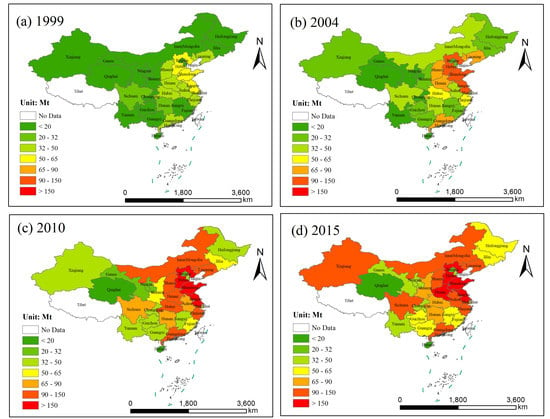Tracking the Spatial–Temporal Evolution of Carbon Emissions in China from 1999 to 2015: A Land Use Perspective
Abstract
:1. Introduction
2. Materials and Methods
2.1. Data Description
2.2. Carbon Emissions Estimation Method
2.2.1. Carbon Emissions of Built-Up Land
2.2.2. Carbon Emissions of Cropland
2.2.3. Carbon Emissions of Grassland
2.2.4. Carbon Sink of Forest Land
2.2.5. Total and Net Carbon Emissions from Land Use
2.3. Carbon Emissions Intensity
2.4. Kuznets Curve Model
3. Results
3.1. Temporal Changes in Land Use Carbon Emissions in China
3.2. Regional Differences in Carbon Emissions
3.3. Spatiotemporal Changes in Provincial Carbon Emissions
3.4. Relationships between Economic Growth, Urbanization, and Carbon Emissions
4. Discussion
5. Conclusions
Supplementary Materials
Author Contributions
Funding
Acknowledgments
Conflicts of Interest
References
- Berrang-Ford, L.; Biesbroek, R.; Ford, J.D.; Lesnikowski, A.; Tanabe, A.; Wang, F.M.; Chen, C.; Hsu, A.; Hellmann, J.J.; Pringle, P. Tracking global climate change adaptation among governments. Nat. Clim. Chang. 2019, 9, 440–449. [Google Scholar] [CrossRef]
- Erickson, P.; Lazarus, M.; Piggot, G. Limiting fossil fuel production as the next big step in climate policy. Nat. Clim. Chang. 2018, 8, 1037–1043. [Google Scholar] [CrossRef]
- Liu, Z.; Geng, Y.; Lindner, S.; Guan, D. Uncovering China’s greenhouse gas emission from regional and sectoral perspectives. Energy 2012, 45, 1059–1068. [Google Scholar] [CrossRef]
- Shan, Y.; Liu, J.; Liu, Z.; Xu, X.; Shao, S.; Wang, P.; Guan, D. New provincial CO2 emission inventories in China based on apparent energy consumption data and updated emission factors. Appl. Energy 2016, 184, 742–750. [Google Scholar] [CrossRef]
- Gregg, J.S.; Andres, R.J.; Marland, G. China: Emissions pattern of the world leader in CO2 emissions from fossil fuel consumption and cement production. Geophys. Res. Lett. 2008. [Google Scholar] [CrossRef]
- Ye, B.; Jiang, J.; Li, C.; Miao, L.; Tang, J. Quantification and driving force analysis of provincial-level carbon emissions in China. Appl. Energy 2017, 198, 223–238. [Google Scholar] [CrossRef]
- Liang, Y.; Niu, D.; Zhou, W.; Fan, Y. Decomposition Analysis of Carbon Emissions from Energy Consumption in Beijing-Tianjin-Hebei, China: A Weighted-Combination Model Based on Logarithmic Mean Divisia Index and Shapley Value. Sustainability 2018, 10, 2535. [Google Scholar] [CrossRef]
- Guan, D.; Meng, J.; Reiner, D.M.; Zhang, N.; Shan, Y.; Mi, Z.; Shao, S.; Liu, Z.; Zhang, Q.; Davis, S.J. Structural decline in China’s CO2 emissions through transitions in industry and energy systems. Nat. Geosci. 2018, 11, 551–555. [Google Scholar] [CrossRef]
- Liu, Z.; Guan, D.; Wei, W.; Davis, S.J.; Ciais, P.; Bai, J.; Peng, S.; Zhang, Q.; Hubacek, K.; Marland, G. Reduced carbon emission estimates from fossil fuel combustion and cement production in China. Nature 2015, 524, 335–338. [Google Scholar] [CrossRef] [Green Version]
- Mi, Z.; Meng, J.; Guan, D.; Shan, Y.; Song, M.; Wei, Y.-M.; Liu, Z.; Hubacek, K. Chinese CO2 emission flows have reversed since the global financial crisis. Nat. Commun. 2017, 8, 1712. [Google Scholar] [CrossRef] [PubMed]
- Tong, X.; Li, X.; Tong, L.; Jiang, X. Spatial spillover and the influencing factors relating to provincial Carbon emissions in China based on the spatial panel data model. Sustainability 2018, 10, 4739. [Google Scholar] [CrossRef]
- Zhong, J. Biased technical change, factor substitution, and carbon emissions efficiency in China. Sustainability 2019, 11, 955. [Google Scholar] [CrossRef]
- Houghton, R.A.; House, J.; Pongratz, J.; Van Der Werf, G.; DeFries, R.; Hansen, M.; Quéré, C.L.; Ramankutty, N. Carbon emissions from land use and land-cover change. Biogeosciences 2012, 9, 5125–5142. [Google Scholar] [CrossRef] [Green Version]
- Chuai, X.; Huang, X.; Wang, W.; Zhao, R.; Zhang, M.; Wu, C. Land use, total carbon emissions change and low carbon land management in Coastal Jiangsu, China. J. Clean. Prod. 2015, 103, 77–86. [Google Scholar] [CrossRef]
- Cui, X.; Wei, X.; Liu, W.; Zhang, F.; Li, Z. Spatial and temporal analysis of carbon sources and sinks through land use/cover changes in the Beijing-Tianjin-Hebei urban agglomeration region. Phys. Chem. Earth Parts A/B/C 2019, 110, 61–70. [Google Scholar] [CrossRef]
- Pei, J.; Niu, Z.; Wang, L.; Song, X.-P.; Huang, N.; Geng, J.; Wu, Y.-B.; Jiang, H.-H. Spatial-temporal dynamics of carbon emissions and carbon sinks in economically developed areas of China: A case study of Guangdong Province. Sci. Rep. 2018, 8, 13383. [Google Scholar] [CrossRef] [PubMed]
- Lu, X.; Kuang, B.; Li, J.; Han, J.; Zhang, Z. Dynamic evolution of regional discrepancies in carbon emissions from agricultural land utilization: Evidence from Chinese provincial data. Sustainability 2018, 10, 552. [Google Scholar] [CrossRef]
- Chuai, X.; Huang, X.; Lu, Q.; Zhang, M.; Zhao, R.; Lu, J. Spatiotemporal changes of built-up land expansion and carbon emissions caused by the Chinese construction industry. Environ. Sci. Technol. 2015, 49, 13021–13030. [Google Scholar] [CrossRef]
- Zhao, R.; Huang, X.; Liu, Y.; Zhong, T.; Ding, M.; Chuai, X. Carbon emission of regional land use and its decomposition analysis: Case study of Nanjing City, China. Chin. Geogr. Sci. 2015, 25, 198–212. [Google Scholar] [CrossRef]
- World Bank. Available online: https://data.worldbank.org/indicator/SP.URB.TOTL.IN.ZS?end=2017&locations=CN&start=1960&view=chart (accessed on 17 April 2019).
- Yao, X.; Kou, D.; Shao, S.; Li, X.; Wang, W.; Zhang, C. Can urbanization process and carbon emission abatement be harmonious? New evidence from China. Environ. Impact Assess. Rev. 2018, 71, 70–83. [Google Scholar] [CrossRef]
- Li, J.; Wang, X. Energy and climate policy in China’s twelfth five-year plan: A paradigm shift. Energy Policy 2012, 41, 519–528. [Google Scholar] [CrossRef]
- Green, F.; Stern, N. China’s changing economy: Implications for its carbon dioxide emissions. Clim. Policy 2017, 17, 423–442. [Google Scholar] [CrossRef]
- Xu, Q.; Dong, Y.-x.; Yang, R. Urbanization impact on carbon emissions in the Pearl River Delta region: Kuznets curve relationships. J. Clean. Prod. 2018, 180, 514–523. [Google Scholar] [CrossRef]
- National Bureau of Statistics of China. Available online: http://www.stats.gov.cn/ (accessed on 19 February 2019).
- China Population & Employment Statistics Yearbook. Available online: http://cdi.cnki.net/Titles/SingleNJ?NJCode=N2016010131 (accessed on 20 February 2019).
- Yang, J.; Wan, Z.; Borjigin, S.; Zhang, D.; Yan, Y.; Chen, Y.; Gu, R.; Gao, Q. Changing Trends of NDVI and Their Responses to Climatic Variation in Different Types of Grassland in Inner Mongolia from 1982 to 2011. Sustainability 2019, 11, 3256. [Google Scholar] [CrossRef]
- Shan, Y.; Guan, D.; Zheng, H.; Ou, J.; Li, Y.; Meng, J.; Mi, Z.; Liu, Z.; Zhang, Q. China CO2 emission accounts 1997–2015. Sci. Data 2018, 5, 170201. [Google Scholar] [CrossRef]
- Feng, K.; Davis, S.J.; Sun, L.; Li, X.; Guan, D.; Liu, W.; Liu, Z.; Hubacek, K. Outsourcing CO2 within China. Proc. Natl. Acad. Sci. USA 2013, 110, 11654–11659. [Google Scholar] [CrossRef]
- 2006 IPCC Guidelines for National Greenhouse Gas Inventories. Available online: https://www.ipcc-nggip.iges.or.jp/public/2006gl/ (accessed on 12 December 2018).
- Ding, Y.; Li, F. Examining the effects of urbanization and industrialization on carbon dioxide emission: Evidence from China’s provincial regions. Energy 2017, 125, 533–542. [Google Scholar] [CrossRef]
- Zheng, H.; Shan, Y.; Mi, Z.; Meng, J.; Ou, J.; Schroeder, H.; Guan, D. How modifications of China’s energy data affect carbon mitigation targets. Energy Policy 2018, 116, 337–343. [Google Scholar] [CrossRef]
- Wang, Y.; Zhang, C.; Lu, A.; Li, L.; He, Y.; ToJo, J.; Zhu, X. A disaggregated analysis of the environmental Kuznets curve for industrial CO2 emissions in China. Appl. Energy 2017, 190, 172–180. [Google Scholar] [CrossRef]
- Bellarby, J.; Tirado, R.; Leip, A.; Weiss, F.; Lesschen, J.P.; Smith, P. Livestock greenhouse gas emissions and mitigation potential in Europe. Glob. Chang. Biol. 2013, 19, 3–18. [Google Scholar] [CrossRef] [PubMed]
- Hu, X.; Wang, J. Estimation of livestock greenhouse gases discharge in China. Trans. Chin. Soc. Agric. Eng. 2010, 26, 247–252. [Google Scholar]
- Solomon, S.; Qin, D.; Manning, M.; Chen, Z.; Marquis, M.; Averyt, K.B.; Tignor, M.; Miller, H.L. Climate change 2007: The physical science basis. Contribution of Working Group I to the Fourth Assessment Report of the Intergovernmental Panel on Climate Change; Cambridge University Press: Cambridge, UK; New York, NY, USA, 2007; p. 996. [Google Scholar]
- Wang, Z.; Geng, L. Carbon emissions calculation from municipal solid waste and the influencing factors analysis in China. J. Clean. Prod. 2015, 104, 177–184. [Google Scholar] [CrossRef]
- Hao, L.; Sun, X.; Jiang, C.Y.; Gong, X.F. Greenhouse gas emission and its reduction strategy from solid waste treatment in Xi’an. China Popul. Res. Environ. 2012, 22, 4. [Google Scholar]
- Zhao, W.; Van Der Voet, E.; Zhang, Y.; Huppes, G. Life cycle assessment of municipal solid waste management with regard to greenhouse gas emissions: Case study of Tianjin, China. Sci. Total Environ. 2009, 407, 1517–1526. [Google Scholar] [CrossRef] [PubMed]
- Zhao, Y.C.; Niu, D.J.; Chai, X.L. Solid Waste Disposal and Resource Recovery; Chemical Industry Press: Beijing, China, 2006. [Google Scholar]
- Piao, S.; Fang, J.; Ciais, P.; Peylin, P.; Huang, Y.; Sitch, S.; Wang, T. The carbon balance of terrestrial ecosystems in China. Nature 2009, 458, 1009–1013. [Google Scholar] [CrossRef] [PubMed]
- Fang, J.; Guo, Z.; Piao, S.; Chen, A. Terrestrial vegetation carbon sinks in China, 1981–2000. Sci. China Ser. D Earth Sci. 2007, 50, 1341–1350. [Google Scholar] [CrossRef]
- Yan, X.; Cai, Z.; Ohara, T.; Akimoto, H. Methane emission from rice fields in mainland China: Amount and seasonal and spatial distribution. J. Geophys. Res. Atmos. 2003. [Google Scholar] [CrossRef]
- Min, J.; Hu, H. Calculation of greenhouse gases emission from agricultural production in China. China Popul. Resour. Environ. 2012, 22, 21–27. [Google Scholar]
- Su, M.; Jiang, R.; Li, R. Investigating Low-Carbon Agriculture: Case Study of China’s Henan Province. Sustainability 2017, 9, 2295. [Google Scholar] [CrossRef]
- Luo, Y.; Long, X.; Wu, C.; Zhang, J. Decoupling CO2 emissions from economic growth in agricultural sector across 30 Chinese provinces from 1997 to 2014. J. Clean. Prod. 2017, 159, 220–228. [Google Scholar] [CrossRef]
- West, T.O.; Marland, G. A synthesis of carbon sequestration, carbon emissions, and net carbon flux in agriculture: Comparing tillage practices in the United States. Agric. Ecosyst. Environ. 2002, 91, 217–232. [Google Scholar] [CrossRef]
- Institute of Resource, Ecosystem and Environment of Agriculture in Nanjing Agricultural University (IREEA). Available online: https://ireea.njau.edu.cn/ (accessed on 5 February 2019).
- Li, B.; Zhang, J.; Li, H. Research on spatial-temporal characteristics and affecting factors decomposition of agricultural carbon emission in China. China Popul. Resour. Environ. 2011, 21, 80–86. [Google Scholar]
- Fang, J.; Yu, G.; Liu, L.; Hu, S.; Chapin, F.S. Climate change, human impacts, and carbon sequestration in China. Proc. Natl. Acad. Sci. USA 2018, 115, 4015–4020. [Google Scholar] [CrossRef] [PubMed] [Green Version]
- Cao, W.; Yuan, X. Region-county characteristic of spatial-temporal evolution and influencing factor on land use-related CO2 emissions in Chongqing of China, 1997–2015. J. Clean. Prod. 2019, 231, 619–632. [Google Scholar] [CrossRef]
- Han, D.; Qiao, R.; Ma, X. Optimization of Land-Use Structure Based on the Trade-Off Between Carbon Emission Targets and Economic Development in Shenzhen, China. Sustainability 2019, 11, 11. [Google Scholar] [CrossRef]
- Du, B.; Zhen, L.; Yan, H.; De Groot, R. Effects of government grassland conservation policy on household livelihoods and dependence on local grasslands: Evidence from Inner Mongolia, China. Sustainability 2016, 8, 1314. [Google Scholar] [CrossRef]
- Han, J.; Meng, X.; Zhou, X.; Yi, B.; Liu, M.; Xiang, W.-N. A long-term analysis of urbanization process, landscape change, and carbon sources and sinks: A case study in China’s Yangtze River Delta region. J. Clean. Prod. 2017, 141, 1040–1050. [Google Scholar] [CrossRef]
- Parajuli, R.; Joshi, O.; Maraseni, T. Incorporating forests, agriculture, and energy consumption in the framework of the Environmental Kuznets Curve: A dynamic panel data approach. Sustainability 2019, 11, 2688. [Google Scholar] [CrossRef]
- Martínez-Zarzoso, I.; Maruotti, A. The impact of urbanization on CO2 emissions: Evidence from developing countries. Ecol. Econ. 2011, 70, 1344–1353. [Google Scholar] [CrossRef]
- Boden, T.A.; Marland, G.; Andres, R.J. Global, Regional, and National Fossil-Fuel CO2 Emissions; Carbon Dioxide Information Analysis Center, Oak Ridge National Laboratory: Oak Ridge, TN, USA, 2017. [CrossRef]
- Olivier, J.G.; Schure, K.; Peters, J. Trends in Global CO2 and Total Greenhouse Gas Emissions; PBL Netherlands Environmental Assessment Agency: The Hague, The Netherlands, 2017; p. 42. [Google Scholar]
- Le Quéré, C.; Andrew, R.; Canadell, J.G.; Sitch, S.; Korsbakken, J.I.; Peters, G.P.; Manning, A.C.; Boden, T.A.; Tans, P.P.; Houghton, R.A. Global carbon budget 2016. Earth Syst. Sci. Data 2016, 8, 605–649. [Google Scholar] [CrossRef]
- British Petroleum (BP). BP Statistical Review of World Energy; British Petroleum: London, UK, 2017. [Google Scholar]
- U.S. Energy Information Administration (EIA). International Energy Statistics: Total Carbon Dioxide Emissions from the Consumption of Energy 2014. Available online: https://www.eia.gov/ (accessed on 4 August 2019).
- Multi-Resolution Emission Inventory for China (MEIC). National CO2 Emissions. Available online: http://www.meicmodel.org/index.html (accessed on 4 August 2019).
- Peters, G.P.; Marland, G.; Le Quéré, C.; Boden, T.; Canadell, J.G.; Raupach, M.R. Rapid growth in CO2 emissions after the 2008–2009 global financial crisis. Nat. Clim. Chang. 2012, 2, 2. [Google Scholar] [CrossRef]
- Zheng, J.; Mi, Z.; Milcheva, S.; Shan, Y.; Guan, D.; Wang, S. Regional development and carbon emissions in China. Energy Econ. 2019, 81, 25–36. [Google Scholar] [CrossRef]
- Piao, S.; Yin, G.; Tan, J.; Cheng, L.; Huang, M.; Li, Y.; Liu, R.; Mao, J.; Myneni, R.B.; Peng, S. Detection and attribution of vegetation greening trend in China over the last 30 years. Glob. Chang. Biol. 2015, 21, 1601–1609. [Google Scholar] [CrossRef]
- Chen, C.; Park, T.; Wang, X.; Piao, S.; Xu, B.; Chaturvedi, R.K.; Fuchs, R.; Brovkin, V.; Ciais, P.; Fensholt, R. China and India lead in greening of the world through land-use management. Nat. Sustain. 2019, 2, 122–129. [Google Scholar] [CrossRef] [PubMed]
- Lu, F.; Hu, H.; Sun, W.; Zhu, J.; Liu, G.; Zhou, W.; Zhang, Q.; Shi, P.; Liu, X.; Wu, X. Effects of national ecological restoration projects on carbon sequestration in China from 2001 to 2010. Proc. Natl. Acad. Sci. USA 2018, 115, 4039–4044. [Google Scholar] [CrossRef] [Green Version]
- Pan, K.-x.; Zhu, H.-x.; Chang, Z.; Wu, K.-h.; Shan, Y.-l.; Liu, Z.-x. Estimation of coal-related CO2 emissions: The case of China. Energy Environ. 2013, 24, 1309–1321. [Google Scholar] [CrossRef]
- Madlener, R.; Sunak, Y. Impacts of urbanization on urban structures and energy demand: What can we learn for urban energy planning and urbanization management? Sustain. Cities Soc. 2011, 1, 45–53. [Google Scholar] [CrossRef]
- Fang, C.; LI GD, Z.Q. The variation characteristics and control measures of the urban construction land in China. J. Nat. Resour. 2017, 32, 363–376. [Google Scholar]
- Abid, M. The close relationship between informal economic growth and carbon emissions in Tunisia since 1980: The (ir) relevance of structural breaks. Sustain. Cities Soc. 2015, 15, 11–21. [Google Scholar] [CrossRef]
- Dinda, S. A theoretical basis for the environmental Kuznets curve. Ecol. Econ. 2005, 53, 403–413. [Google Scholar] [CrossRef]
- Liu, Z.; Guan, D.; Moore, S.; Lee, H.; Su, J.; Zhang, Q. Climate policy: Steps to China’s carbon peak. Nat. News 2015, 522, 279. [Google Scholar] [CrossRef] [PubMed]
- Viña, A.; McConnell, W.J.; Yang, H.; Xu, Z.; Liu, J. Effects of conservation policy on China’s forest recovery. Sci. Adv. 2016, 2, e1500965. [Google Scholar] [CrossRef]
- Huang, L.; Liu, J.; Shao, Q.; Xu, X. Carbon sequestration by forestation across China: Past, present, and future. Renew. Sustain. Energy Rev. 2012, 16, 1291–1299. [Google Scholar] [CrossRef]
- Tong, X.; Brandt, M.; Yue, Y.; Horion, S.; Wang, K.; De Keersmaecker, W.; Tian, F.; Schurgers, G.; Xiao, X.; Luo, Y. Increased vegetation growth and carbon stock in China karst via ecological engineering. Nat. Sustain. 2018, 1, 44–50. [Google Scholar] [CrossRef]
- Sun, W.; Song, X.; Mu, X.; Gao, P.; Wang, F.; Zhao, G. Spatiotemporal vegetation cover variations associated with climate change and ecological restoration in the Loess Plateau. Agric. For. Meteorol. 2015, 209, 87–99. [Google Scholar] [CrossRef]
- Zheng, J.; Hu, Y.; Dong, S.; Li, Y. The Spatiotemporal Pattern of Decoupling Transport CO2 Emissions from Economic Growth across 30 Provinces in China. Sustainability 2019, 11, 2564. [Google Scholar] [CrossRef]
- Li, S.; Zhou, C. What are the impacts of demographic structure on CO2 emissions? A regional analysis in China via heterogeneous panel estimates. Sci. Total Environ. 2019, 650, 2021–2031. [Google Scholar] [CrossRef]
- Lin, X.; Ren, J.; Xu, J.; Zheng, T.; Cheng, W.; Qiao, J.; Huang, J.; Li, G. Prediction of Life Cycle Carbon Emissions of Sponge City Projects: A Case Study in Shanghai, China. Sustainability 2018, 10, 3978. [Google Scholar] [CrossRef]
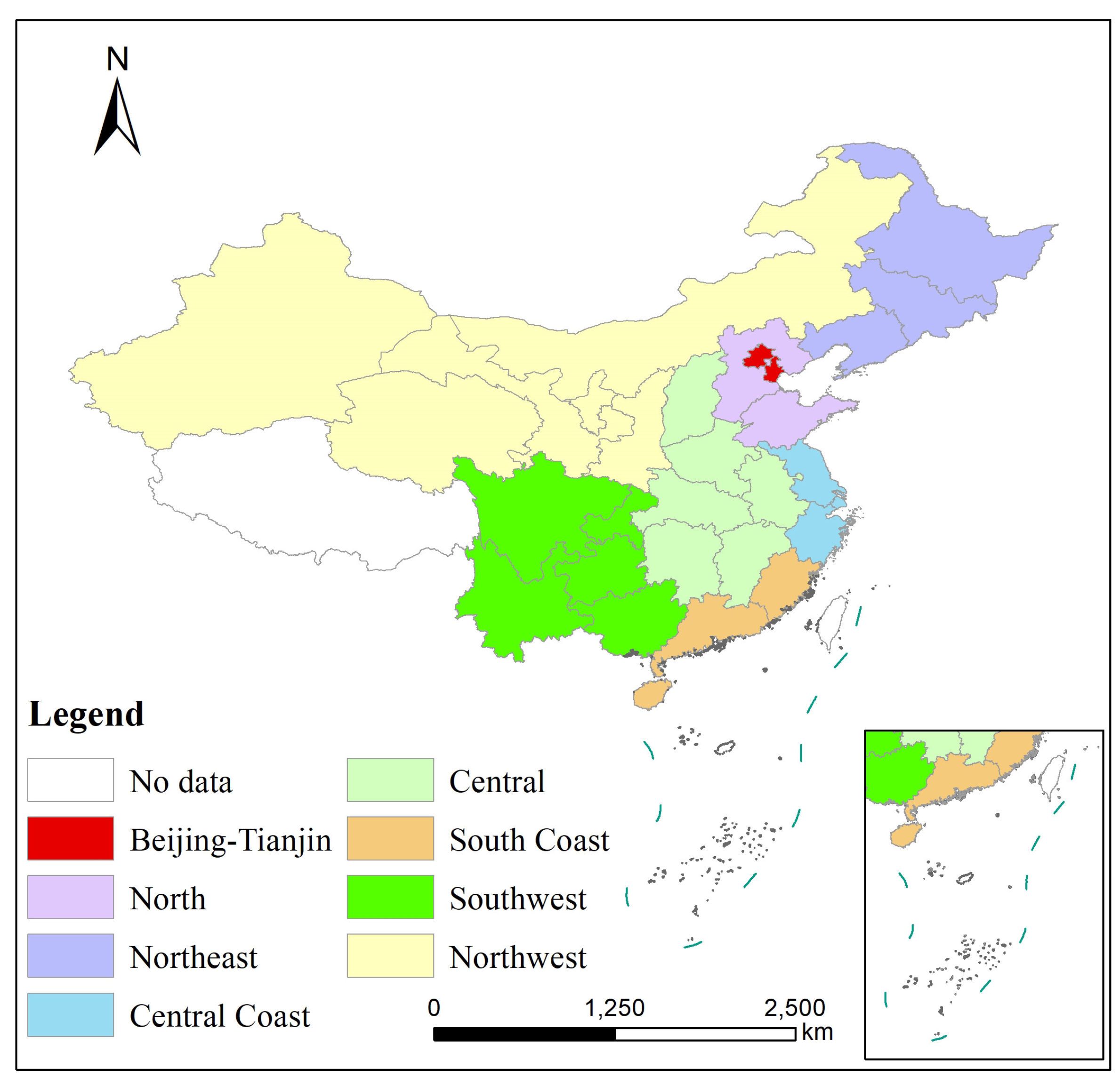
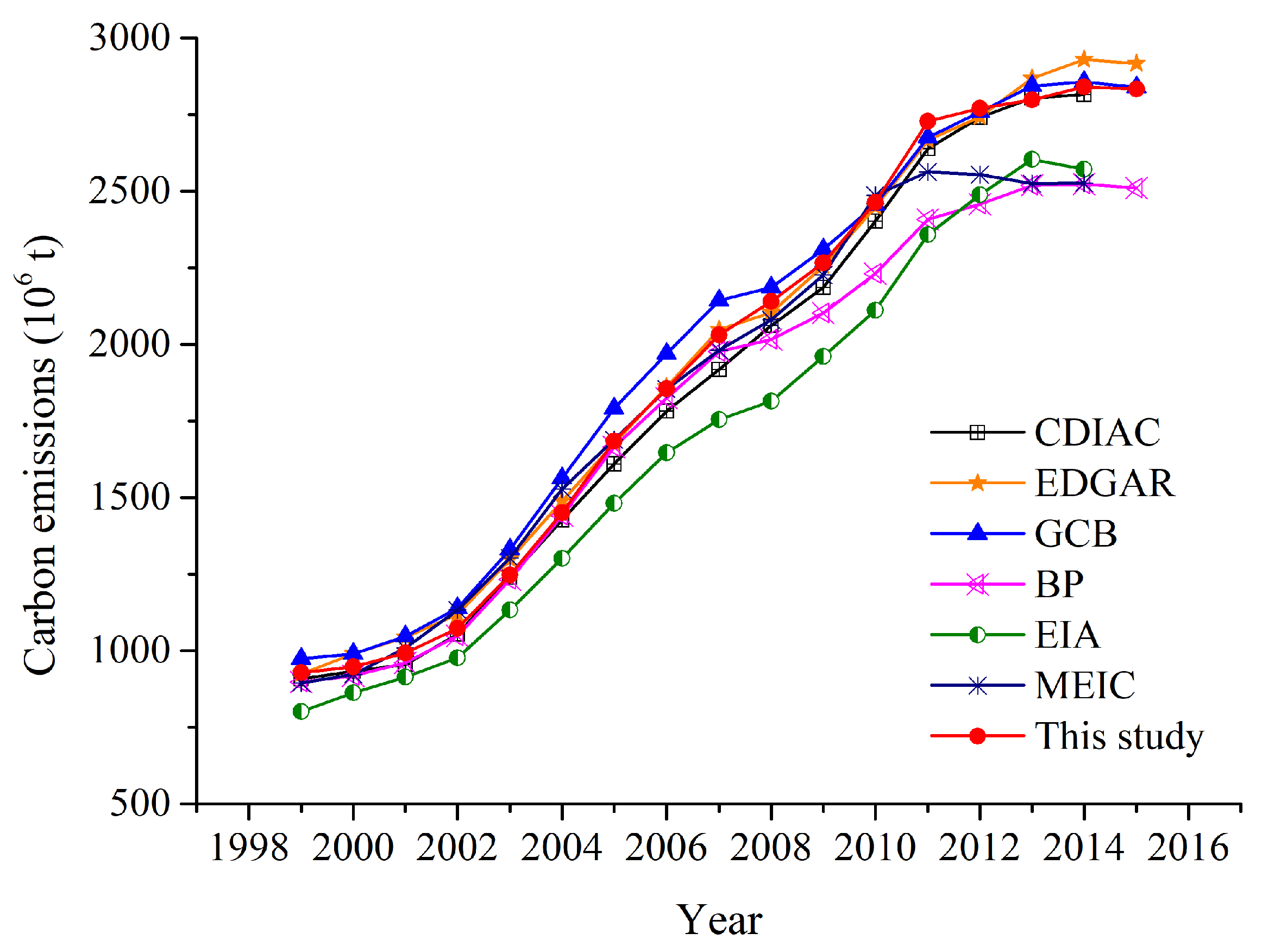
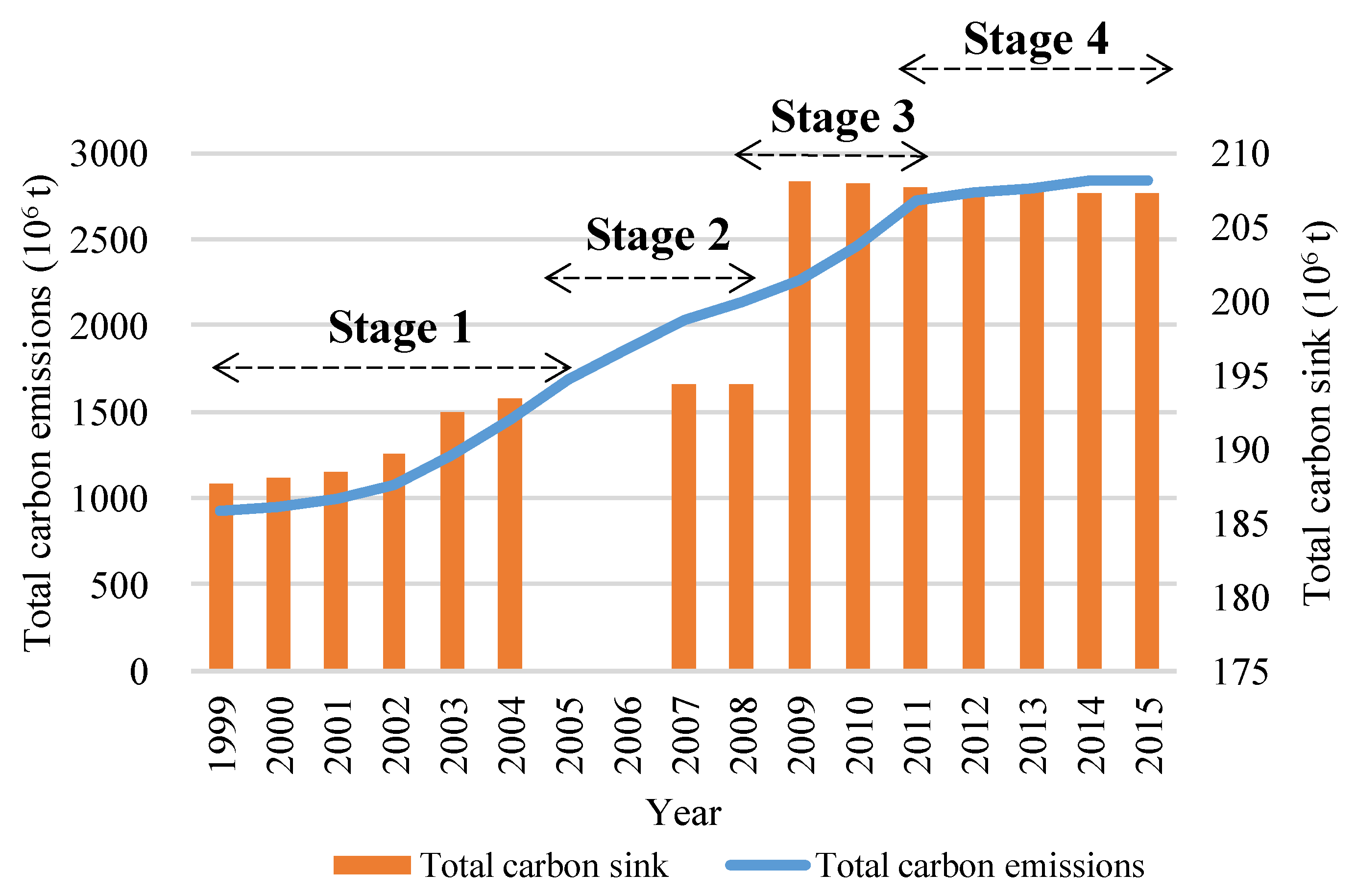
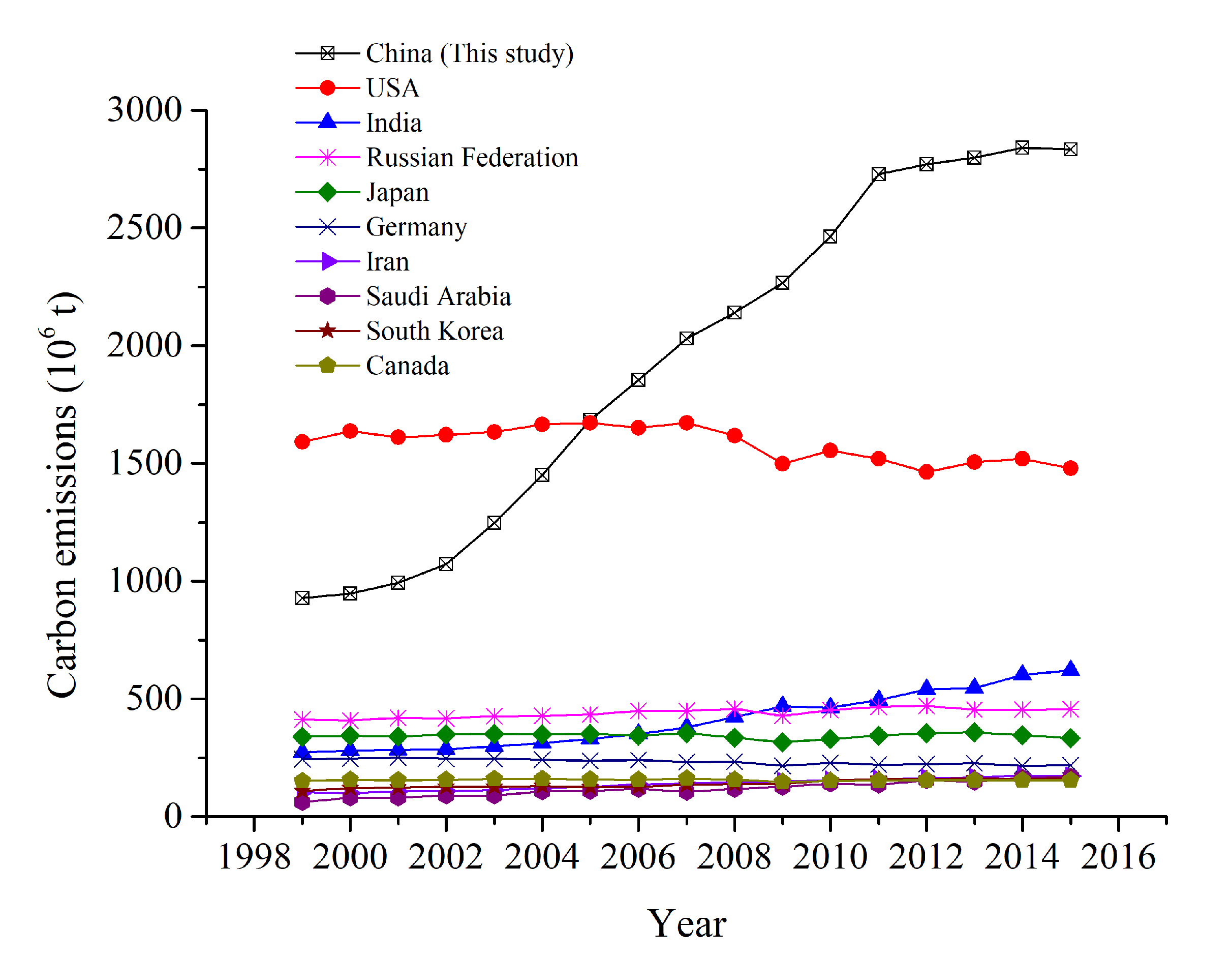

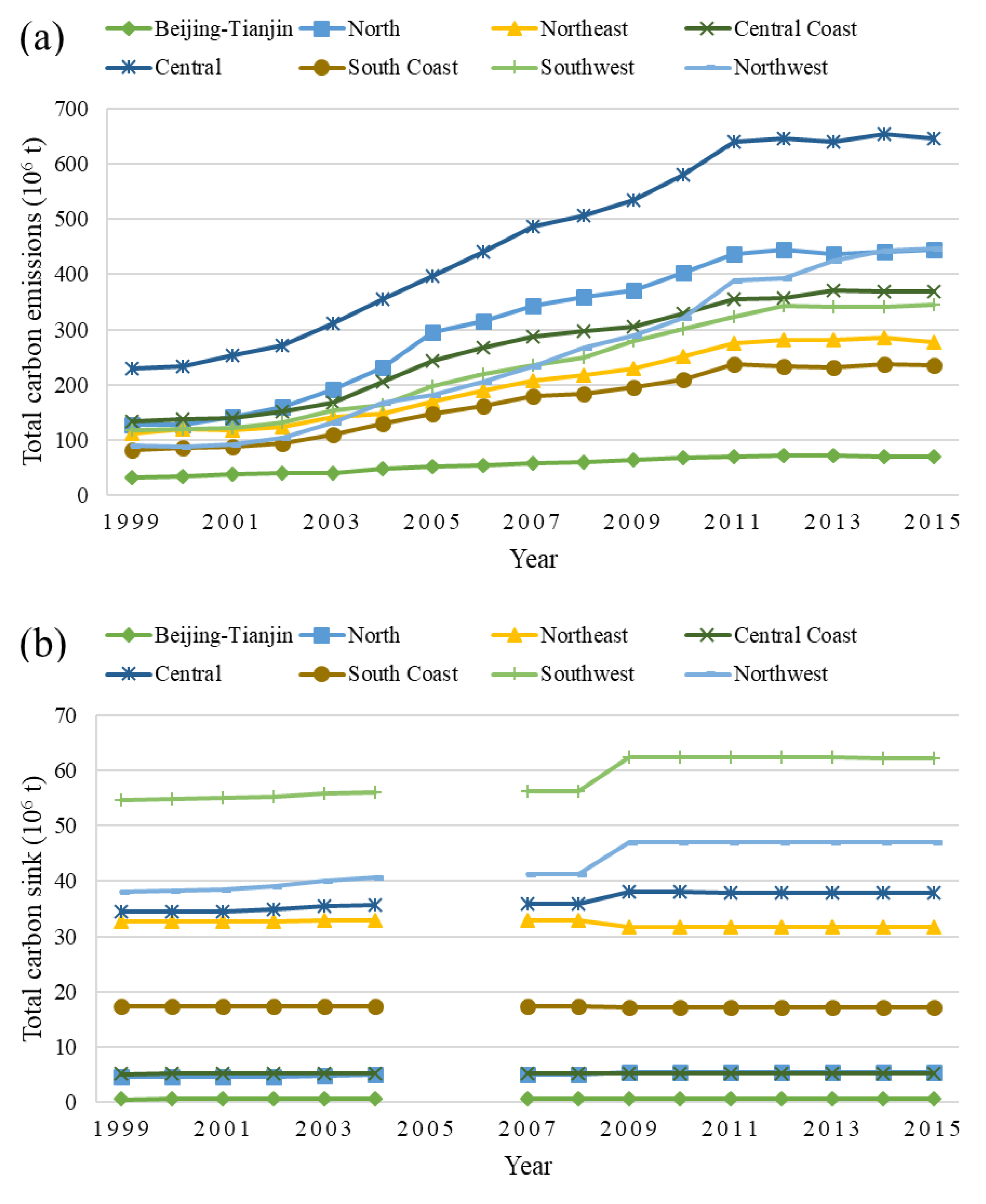

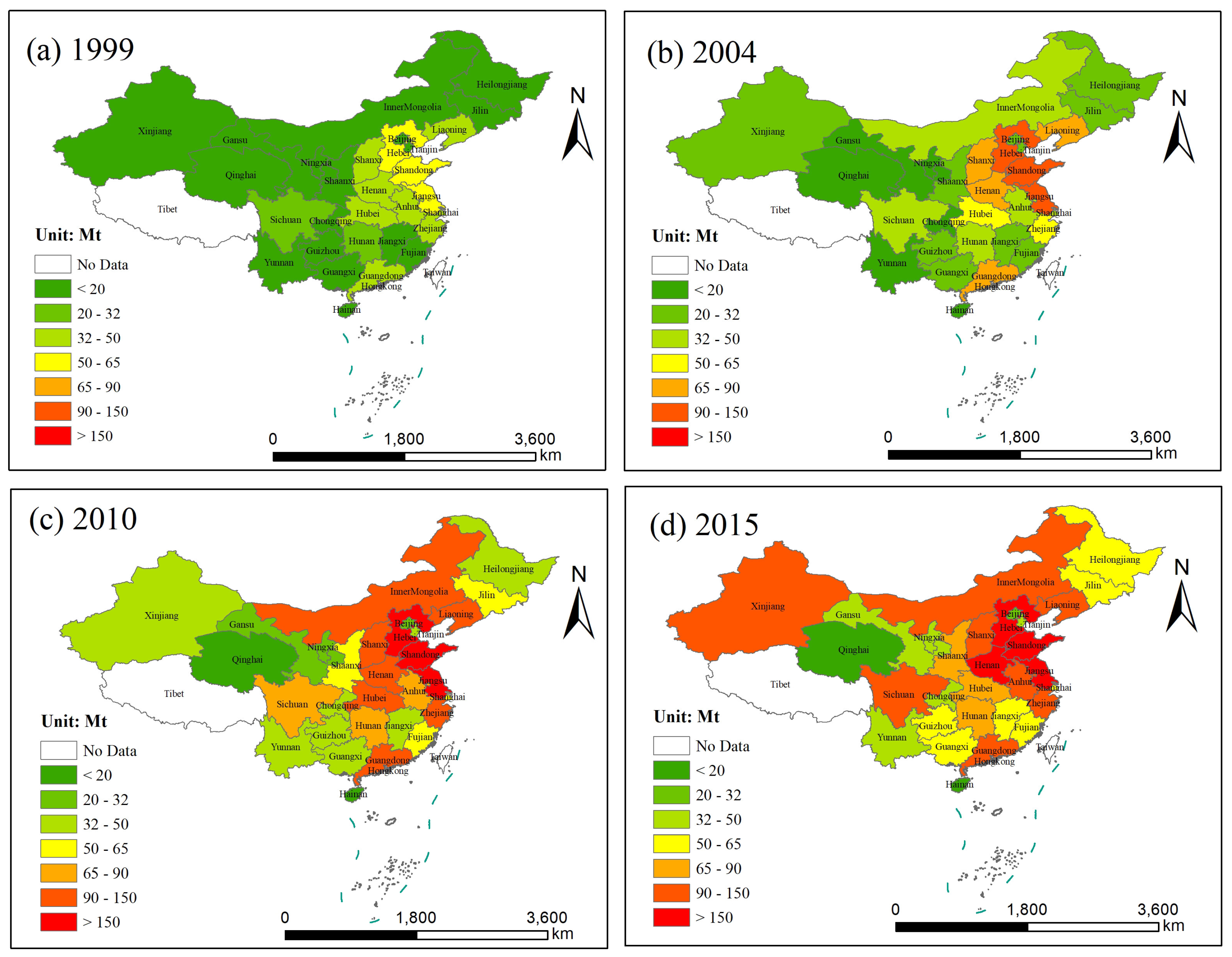
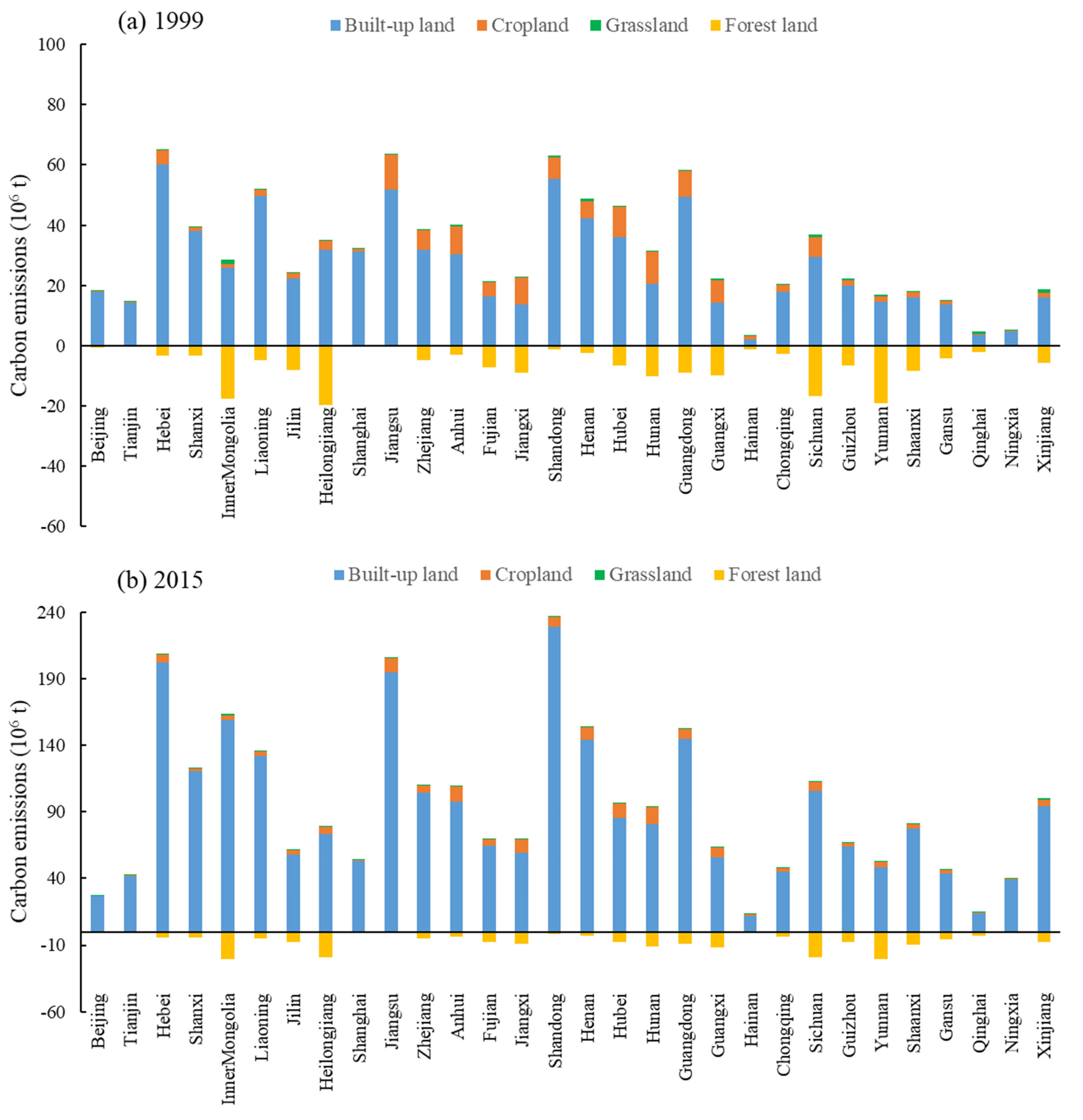
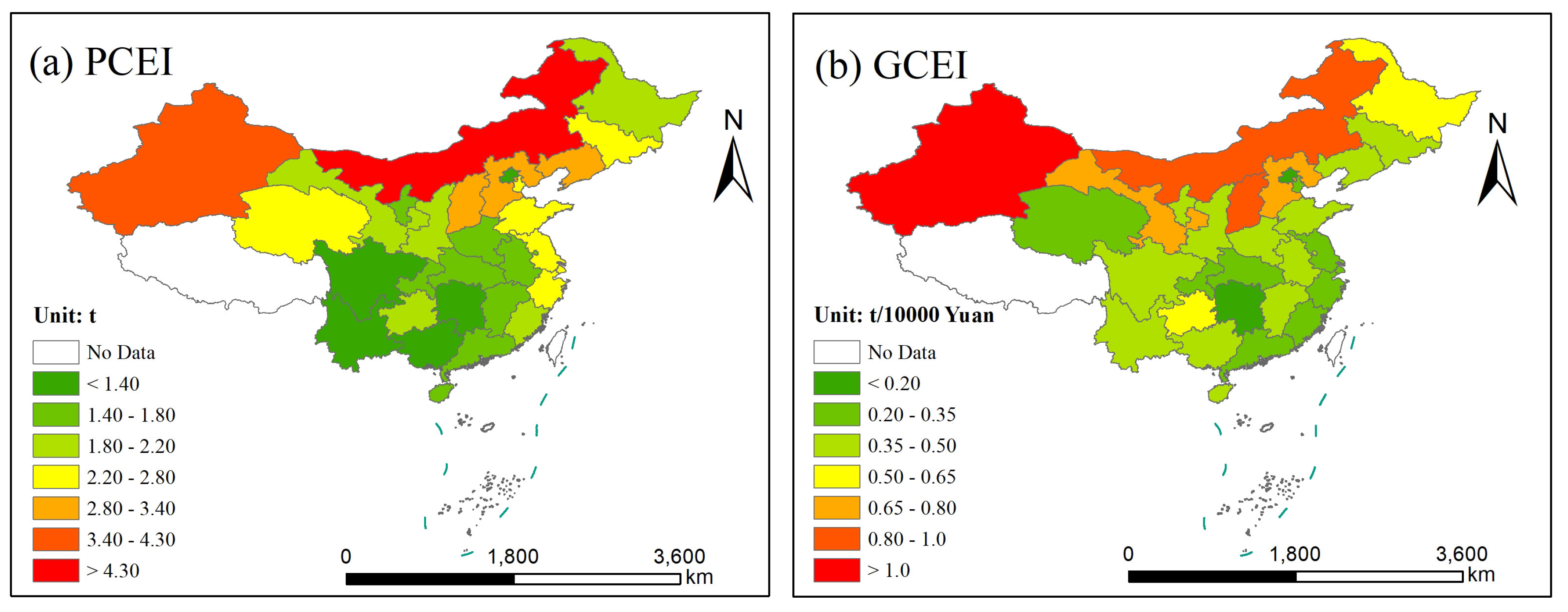
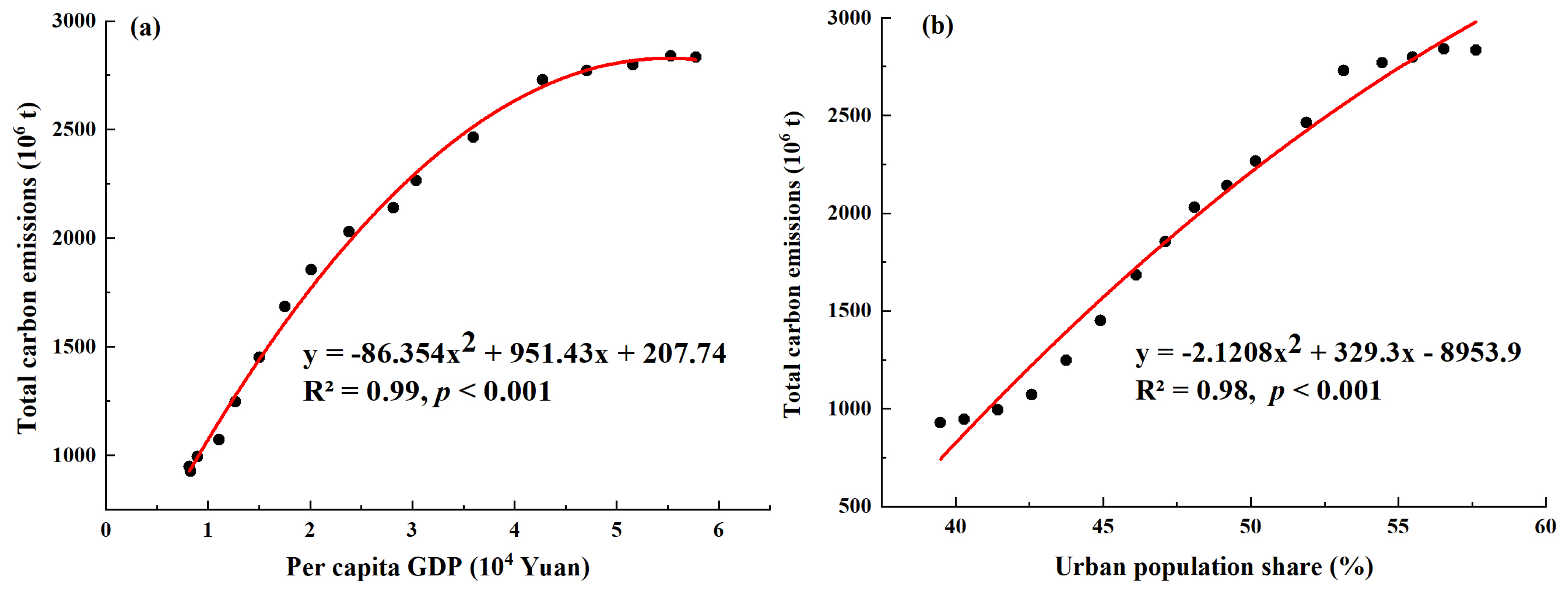
| Region | Provinces |
|---|---|
| Beijing–Tianjin | Beijing, Tianjin |
| North | Hebei, Shandong |
| Northeast | Liaoning, Jilin, Heilongjiang |
| Central Coast | Shanghai, Jiangsu, Zhejiang |
| Central | Shanxi, Anhui, Jiangxi, Henan, Hubei, Hunan |
| South Coast | Fujian, Guangdong, Hainan |
| Southwest | Guangxi, Chongqing, Sichuan, Guizhou, Yunnan |
| Northwest | Inner Mongolia, Shaanxi, Gansu, Qinghai, Ningxia, Xinjiang |
| Intergovernmental Panel on Climate Change (IPCC) Guidelines for National Greenhouse Gas Inventories | ||||
|---|---|---|---|---|
| Land Use Types | Energy Consumption | Industrial Processes | Agriculture, Forestry, and Other Land Use | Waste |
| Cropland | Farming | — | Soil and paddy fields | — |
| Forest land | Forestry | — | Vegetation and soil | — |
| Grassland | Animal husbandry | — | Vegetation and soil, enteric and manure fermentation of livestock 1 | — |
| Water bodies | Fisheries and water conservancy | — | Vegetation and soil | — |
| Unused land | — | — | Vegetation and soil | — |
| Urban land | Urban household consumption | — | Vegetation and soil | Wastewater and solid waste from urban households |
| Rural residential land | Rural household consumption | — | Vegetation and soil, enteric and manure fermentation of domestic livestock | Wastewater and solid waste from rural households |
| Industry–traffic land | Industry, construction, transportation, storage, post, and telecommunications services; wholesale, retail trade, and catering services | Industrial production | Soil | Industrial waste, water and solid waste |
| Emissions Source | Cattle | Sheep | Camel | Horse | Mule | Donkey | Pig | Poultry |
|---|---|---|---|---|---|---|---|---|
| Enteric fermentation | 56.93 | 5.00 | 46.00 | 18.00 | 10.00 | 10.00 | 1.00 | 0.00 |
| Manure management | 6.33 | 0.16 | 1.92 | 1.64 | 0.90 | 0.90 | 3.50 | 0.02 |
| Total | 63.26 | 5.16 | 47.92 | 19.64 | 10.90 | 10.90 | 4.50 | 0.02 |
| Carbon Source | Coefficient | Reference |
|---|---|---|
| Fertilizer | 0.8956 kg C/kg | West and Marland [47] |
| Pesticide | 4.9341 kg C/kg | Luo et al. [46] |
| Agricultural plastic film | 5.18 kg C/kg | IREEA 1 [48] |
| Agricultural diesel | 0.5927 kg C/kg | IPCC [30] |
| Agricultural irrigation | 20.476 kg C/ha | Li et al. [49] |
| Tillage | 312.6 kg C/km2 | Lu et al. [17] |
| Year | Land Use Carbon Emissions/Sinks (106 t) | TCE | TCS | NCE | LCEI | GCEI | PCEI | |||
|---|---|---|---|---|---|---|---|---|---|---|
| Built-Up Land | Cropland | Grassland | Forest Land | |||||||
| 1999 | 791.68 | 124.57 | 11.63 | 187.58 | 927.88 | 187.58 | 740.30 | 0.42 | 1.15 | 0.83 |
| 85.32% | 13.43% | 1.25% | 100% | 100% | 100% | |||||
| 2000 | 812.59 | 122.90 | 11.70 | 188.03 | 947.19 | 188.03 | 759.16 | 0.43 | 1.05 | 0.83 |
| 85.79% | 12.97% | 1.23% | 100% | 100% | 100% | |||||
| 2001 | 858.65 | 122.22 | 11.77 | 188.38 | 992.64 | 188.38 | 804.26 | 0.44 | 1.00 | 0.86 |
| 86.50% | 12.31% | 1.19% | 100% | 100% | 100% | |||||
| 2002 | 937.53 | 123.12 | 11.87 | 189.70 | 1072.53 | 189.70 | 882.82 | 0.47 | 0.97 | 0.91 |
| 87.41% | 11.48% | 1.11% | 100% | 100% | 100% | |||||
| 2003 | 1113.56 | 121.72 | 12.16 | 192.52 | 1247.44 | 192.52 | 1054.92 | 0.52 | 1.01 | 1.06 |
| 89.27% | 9.76% | 0.98% | 100% | 100% | 100% | |||||
| 2004 | 1308.56 | 129.81 | 12.49 | 193.46 | 1450.86 | 193.46 | 1257.40 | 0.60 | 0.96 | 1.22 |
| 90.19% | 8.95% | 0.86% | 100% | 100% | 100% | |||||
| 2005 | 1537.61 | 133.32 | 12.74 | 0.00 | 1683.67 | 0.00 | 1683.67 | 0.67 | 0.92 | 1.36 |
| 91.32% | 7.92% | 0.76% | 100% | 100% | 100% | |||||
| 2006 | 1708.14 | 135.12 | 11.47 | 0.00 | 1854.73 | 0.00 | 1854.73 | 0.72 | 0.87 | 1.49 |
| 92.10% | 7.29% | 0.62% | 100% | 100% | 100% | |||||
| 2007 | 1881.76 | 138.19 | 10.15 | 194.39 | 2030.09 | 194.39 | 1835.71 | 0.78 | 0.79 | 1.62 |
| 92.69% | 6.81% | 0.50% | 100% | 100% | 100% | |||||
| 2008 | 1990.13 | 139.84 | 10.17 | 194.37 | 2140.14 | 194.37 | 1945.77 | 0.81 | 0.69 | 1.70 |
| 92.99% | 6.53% | 0.47% | 100% | 100% | 100% | |||||
| 2009 | 2113.66 | 142.81 | 10.27 | 208.02 | 2266.74 | 208.02 | 2058.72 | 0.84 | 0.68 | 1.79 |
| 93.25% | 6.30% | 0.45% | 100% | 100% | 100% | |||||
| 2010 | 2307.85 | 145.52 | 10.30 | 207.86 | 2463.67 | 207.86 | 2255.81 | 0.90 | 0.61 | 1.91 |
| 93.68% | 5.91% | 0.42% | 100% | 100% | 100% | |||||
| 2011 | 2570.35 | 147.90 | 10.19 | 207.68 | 2728.43 | 207.68 | 2520.75 | 0.98 | 0.57 | 2.13 |
| 94.21% | 5.42% | 0.37% | 100% | 100% | 100% | |||||
| 2012 | 2609.83 | 149.84 | 10.11 | 207.54 | 2769.78 | 207.54 | 2562.24 | 0.98 | 0.52 | 2.17 |
| 94.23% | 5.41% | 0.37% | 100% | 100% | 100% | |||||
| 2013 | 2636.88 | 151.35 | 10.13 | 207.42 | 2798.36 | 207.42 | 2590.94 | 0.99 | 0.48 | 2.20 |
| 94.23% | 5.41% | 0.36% | 100% | 100% | 100% | |||||
| 2014 | 2676.91 | 152.84 | 10.25 | 207.26 | 2840.00 | 207.26 | 2632.74 | 0.98 | 0.46 | 2.22 |
| 94.26% | 5.38% | 0.36% | 100% | 100% | 100% | |||||
| 2015 | 2670.01 | 153.46 | 10.44 | 207.19 | 2833.91 | 207.19 | 2626.72 | 0.97 | 0.44 | 2.19 |
| 94.22% | 5.42% | 0.37% | 100.00% | 100% | 100% | |||||
| Province | Cumulative Emissions (106 t) | Province | Cumulative Emissions (106 t) |
|---|---|---|---|
| Beijing | 437.20 | Henan | 1892.29 |
| Tianjin | 505.67 | Hubei | 1304.63 |
| Hebei | 2481.08 | Hunan | 1114.71 |
| Shanxi | 1556.75 | Guangdong | 1926.17 |
| Inner Mongolia | 1680.37 | Guangxi | 746.64 |
| Liaoning | 1667.44 | Hannan | 132.72 |
| Jilin | 806.19 | Chongqing | 546.13 |
| Heilongjiang | 954.37 | Sichuan | 1199.13 |
| Shanghai | 785.32 | Guizhou | 783.20 |
| Jiangsu | 2300.26 | Yunnan | 706.73 |
| Zhejiang | 1399.48 | Shaanxi | 779.65 |
| Anhui | 1206.54 | Gansu | 513.65 |
| Fujian | 785.63 | Qinghai | 152.97 |
| Jiangxi | 747.40 | Ningxia | 360.38 |
| Shandong | 2793.54 | Xinjiang | 781.77 |
| 1999 | 2015 | |||||||
|---|---|---|---|---|---|---|---|---|
| Province | Built-Up Land | Cropland | Grassland | Forest Land | Built-Up Land | Cropland | Grassland | Forest Land |
| Beijing | 17.93 | 0.32 | 0.01 | −0.55 | 26.53 | 0.18 | 0.02 | −0.64 |
| Tianjin | 14.30 | 0.38 | 0.01 | −0.03 | 41.97 | 0.38 | 0.02 | −0.05 |
| Hebei | 60.26 | 4.50 | 0.56 | −3.40 | 201.98 | 6.08 | 0.37 | −4.02 |
| Shanxi | 38.10 | 1.17 | 0.21 | −3.25 | 120.77 | 1.68 | 0.16 | −4.25 |
| Inner Mongolia | 25.97 | 1.22 | 1.26 | −17.66 | 159.11 | 3.32 | 1.44 | −20.32 |
| Liaoning | 49.63 | 2.17 | 0.17 | −4.90 | 131.99 | 3.21 | 0.30 | −4.91 |
| Jilin | 22.43 | 1.68 | 0.31 | −8.00 | 58.02 | 3.42 | 0.31 | −7.74 |
| Heilongjiang | 31.86 | 2.99 | 0.36 | −19.79 | 73.16 | 5.92 | 0.39 | −19.08 |
| Shanghai | 31.16 | 1.05 | 0.01 | 0.00 | 52.90 | 0.58 | 0.01 | −0.04 |
| Jiangsu | 51.91 | 11.43 | 0.09 | −0.27 | 194.56 | 11.38 | 0.04 | −0.23 |
| Zhejiang | 31.75 | 6.54 | 0.04 | −4.82 | 104.38 | 5.36 | 0.02 | −4.94 |
| Anhui | 30.39 | 9.24 | 0.41 | −2.94 | 97.55 | 11.67 | 0.14 | −3.28 |
| Fujian | 16.21 | 4.93 | 0.08 | −7.27 | 64.77 | 4.33 | 0.05 | −7.29 |
| Jiangxi | 13.80 | 8.83 | 0.24 | −8.90 | 59.09 | 10.35 | 0.20 | −9.04 |
| Shandong | 55.32 | 7.16 | 0.75 | −1.14 | 229.07 | 7.74 | 0.44 | −1.30 |
| Henan | 42.21 | 5.69 | 1.00 | −2.46 | 144.15 | 9.52 | 0.69 | −3.04 |
| Hubei | 36.09 | 10.03 | 0.28 | −6.69 | 85.20 | 11.30 | 0.25 | −7.52 |
| Hunan | 20.62 | 10.52 | 0.33 | −10.22 | 80.53 | 13.03 | 0.33 | −10.68 |
| Guangdong | 49.52 | 8.48 | 0.27 | −8.93 | 144.59 | 8.04 | 0.16 | −8.77 |
| Guangxi | 14.25 | 7.43 | 0.52 | −9.98 | 55.61 | 7.46 | 0.31 | −11.64 |
| Hainan | 2.05 | 1.18 | 0.09 | −1.25 | 11.78 | 1.62 | 0.06 | −1.05 |
| Chongqing | 17.85 | 2.27 | 0.11 | −2.58 | 44.82 | 2.56 | 0.11 | −3.33 |
| Sichuan | 29.51 | 6.60 | 0.85 | −16.58 | 105.47 | 7.07 | 0.88 | −19.37 |
| Guizhou | 19.83 | 1.92 | 0.46 | −6.62 | 64.23 | 2.37 | 0.38 | −7.82 |
| Yunnan | 14.49 | 1.81 | 0.59 | −18.97 | 48.33 | 4.07 | 0.58 | −20.13 |
| Shaanxi | 16.03 | 1.83 | 0.22 | −8.24 | 77.73 | 3.06 | 0.16 | −9.79 |
| Gansu | 13.73 | 1.09 | 0.43 | −4.05 | 43.87 | 2.51 | 0.56 | −5.33 |
| Qinghai | 3.69 | 0.11 | 0.81 | −2.12 | 14.26 | 0.18 | 0.87 | −3.10 |
| Ningxia | 4.70 | 0.40 | 0.08 | −0.23 | 39.06 | 0.64 | 0.12 | −0.67 |
| Xinjiang | 16.11 | 1.58 | 1.06 | −5.71 | 94.57 | 4.42 | 1.07 | −7.84 |
| Province | Total Carbon Emissions (106 t) | Total Carbon Sink (106 t) | GDP per Capita (104 Yuan) | Per Capita Carbon Emissions (t) | CEI per Unit GDP (t/104 Yuan) | CEI per Unit Land Area (103 t/km2) |
|---|---|---|---|---|---|---|
| Beijing | 26.73 | 0.64 | 10.60 | 1.23 | 0.12 | 1.57 |
| Tianjin | 42.37 | 0.05 | 10.69 | 2.74 | 0.26 | 3.53 |
| Hebei | 208.42 | 4.02 | 4.01 | 2.81 | 0.70 | 1.10 |
| Shanxi | 122.62 | 4.25 | 3.48 | 3.35 | 0.96 | 0.77 |
| Inner Mongolia | 163.86 | 20.32 | 7.10 | 6.53 | 0.92 | 0.14 |
| Liaoning | 135.49 | 4.91 | 6.78 | 3.20 | 0.47 | 0.90 |
| Jilin | 61.76 | 7.74 | 5.28 | 2.32 | 0.44 | 0.33 |
| Heilongjiang | 79.47 | 19.08 | 3.96 | 2.08 | 0.53 | 0.17 |
| Shanghai | 53.48 | 0.04 | 10.40 | 2.21 | 0.21 | 8.49 |
| Jiangsu | 205.98 | 0.23 | 8.79 | 2.58 | 0.29 | 2.06 |
| Zhejiang | 109.75 | 4.94 | 8.80 | 2.25 | 0.26 | 1.10 |
| Anhui | 109.35 | 3.28 | 3.58 | 1.78 | 0.50 | 0.78 |
| Fujian | 69.16 | 7.29 | 6.77 | 1.80 | 0.27 | 0.58 |
| Jiangxi | 69.65 | 9.04 | 3.66 | 1.53 | 0.42 | 0.41 |
| Shandong | 237.24 | 1.30 | 6.40 | 2.41 | 0.38 | 1.48 |
| Henan | 154.36 | 3.04 | 3.45 | 1.44 | 0.42 | 0.91 |
| Hubei | 96.76 | 7.52 | 5.05 | 1.65 | 0.33 | 0.51 |
| Hunan | 93.89 | 10.68 | 9.63 | 1.30 | 0.13 | 0.45 |
| Guangdong | 152.79 | 8.77 | 8.08 | 1.70 | 0.21 | 0.80 |
| Guangxi | 63.38 | 11.64 | 3.05 | 1.15 | 0.38 | 0.26 |
| Hainan | 13.46 | 1.05 | 4.08 | 1.48 | 0.36 | 0.40 |
| Chongqing | 47.48 | 3.33 | 4.66 | 1.41 | 0.30 | 0.58 |
| Sichuan | 113.41 | 19.37 | 3.66 | 1.38 | 0.38 | 0.23 |
| Guizhou | 66.98 | 7.82 | 2.98 | 1.90 | 0.64 | 0.37 |
| Yunnan | 52.97 | 20.13 | 2.87 | 1.12 | 0.39 | 0.14 |
| Shaanxi | 80.95 | 9.79 | 4.75 | 2.13 | 0.45 | 0.39 |
| Gansu | 46.94 | 5.33 | 2.61 | 1.81 | 0.69 | 0.11 |
| Qinghai | 15.32 | 3.10 | 4.14 | 2.60 | 0.26 | 0.02 |
| Ningxia | 39.81 | 0.67 | 3.95 | 1.69 | 0.43 | 0.60 |
| Xinjiang | 100.06 | 7.84 | 3.95 | 4.24 | 1.07 | 0.06 |
© 2019 by the authors. Licensee MDPI, Basel, Switzerland. This article is an open access article distributed under the terms and conditions of the Creative Commons Attribution (CC BY) license (http://creativecommons.org/licenses/by/4.0/).
Share and Cite
Wang, L.; Pei, J.; Geng, J.; Niu, Z. Tracking the Spatial–Temporal Evolution of Carbon Emissions in China from 1999 to 2015: A Land Use Perspective. Sustainability 2019, 11, 4531. https://doi.org/10.3390/su11174531
Wang L, Pei J, Geng J, Niu Z. Tracking the Spatial–Temporal Evolution of Carbon Emissions in China from 1999 to 2015: A Land Use Perspective. Sustainability. 2019; 11(17):4531. https://doi.org/10.3390/su11174531
Chicago/Turabian StyleWang, Li, Jie Pei, Jing Geng, and Zheng Niu. 2019. "Tracking the Spatial–Temporal Evolution of Carbon Emissions in China from 1999 to 2015: A Land Use Perspective" Sustainability 11, no. 17: 4531. https://doi.org/10.3390/su11174531




